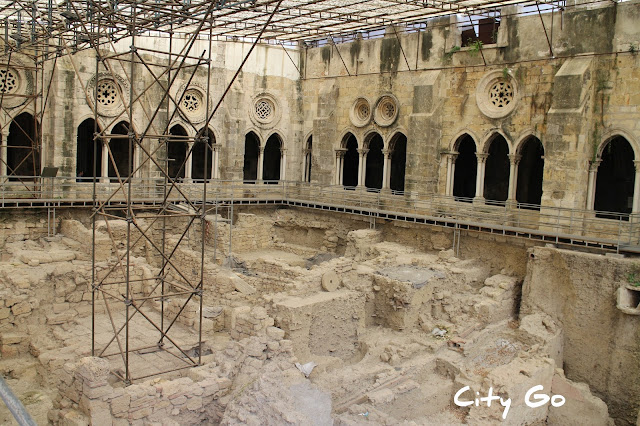Alfama, Lisbon, Portugal
Alfama is the oldest and most typical neighborhood in Lisbon. Its name comes from the Arabic "al hamman", meaning the baths or fountains, a reminder that this neighborhood was once the main supplier of water to the city.
During Moorish domination, Alfama, together with the castle, constituted the whole of the city. It was divided in two, a more aristocratic upper Alfama, within the Moorish walls, and a more popular riverside Alfama (Alfama Mar).
With the Christian conquest of Lisbon, Alfama spread to the east while the city spread to the west, to Baixa neighborhood. Decline begun in the Middle Ages when the wealthier part of the population abandoned the neighborhood and moved west, leaving it to the fishermen and the poor.
Unlike in other parts of the city, most houses resisted the 1755 earthquake, and the neighborhood maintained its medieval layout, so although none of the houses dates back to that period, wandering through Alfama's maze will give you a sense of what the city was like during Arab domination.
You can start your visit to Alfama at Miradouro Portas do Sol for a panoramic overview of the city and the neighborhood of Alfama.
Facing the river turn to your right, to Rua Norberto de Araujo, where you can appreciate part of the Moorish wall built in the 10th century. Go down the stairs and turn left at Calçadinha da Figueira.
Go down through Beco da Corvinha to reach São Miguel Church. This church dates back to the 12th century but was totally renovated in the 17th century in the baroque and mannerist styles. Unfortunately, it's almost always closed, opening only for mass service.
Go around the church, through Largo de São Miguel and then left to Rua de São Miguel. Go strait ahead until the end of the street and turn left to Rua da Regueira and then turn right to Largo do Peneireiro.Go down through Beco da Corvinha to reach São Miguel Church. This church dates back to the 12th century but was totally renovated in the 17th century in the baroque and mannerist styles. Unfortunately, it's almost always closed, opening only for mass service.
At Largo do Peneireiro you can see some houses displaying Moorish influences with their shades over the window and balcony, very common in Southern Spain but only seen in Alfama here in Portugal.
Turn left and go up the stairs; once you reach the top turn right to Santo Estevão Church.
Turn left and go up the stairs; once you reach the top turn right to Santo Estevão Church.
This church was also originally built in the 12th century in the Romanesque style after Lisbon was conquered by the Christian forces but was extensively renovated in 1733.
It was badly damaged by the 1755 earthquake and was repaired, being again opened to the public in 1773.It is also usually closed but here you can enjoy the scenic overview.Go down the stairs, in the direction of the tiled houses and turn right, where you'll see a tiled fountain from the 18th century.
Go down the stairs through Escadinhas de Santo Estevao and notice on your right the tile panel indicating an old public bathhouse.
Once you've reached the bottom of the stairs, turn left- number 2 of Escadinhas de Santo Estevao is a Manueline doorway.You've now reached Rua dos Remédios; turn right to Largo do Chafariz de Dentro and on your way, you'll see, on your right, another Manueline doorway just before you reach the square.
The chafariz (fountain) dates back to the 13th century and the name (de Dentro, meaning inside) comes from the fact that it used to be located within the old walls or Moorish walls and there was another fountain outside the walls, the Chafariz da Praia (beach fountain) now located in the Fado Museum.
Continue your walk through Rua de São Pedro to Largo de São Rafael. Here you can see another segment of the 10th-century Moorish wall, the Sao Pedro tower. This tower was probably built to protect a water spring located there and was later used as a prison in the 14th and 15th centuries.
Turn left at Largo de Sao Rafael, go down the hill, pass through the fountain and you'll have reached Rua Judiaria. Here you can see Postigo de Sao Pedro, a wall section probably built as a "couraça" (a wall with double parapet), which rests on a rocky bed parallel to the river. It connects the tower of S.Pedro to the wall's perimeter.
This series of walls enclosed the Jewish quarter of Alfama, which existed since the 14th century and was extinct in 1496 with the expulsion or forced conversion of Portuguese Jews.
A palace was built upon the walls between the late 15th and early 16th centuries.
Go through the arch, thus leaving the maze, and turn right to find another of Alfama's fountains, the Chafariz d'El Rei (King's fountain). This fountain is one of the oldest in the city, probably dating back to Moorish times. It was rebuilt in the 13th century but the current facade is from the 19th century. The fountain's taps increased from three to six and then to nine, mainly to avoid riots, as each tap was destined for a specific social group.
Back to Lisbon




















Comments
Post a Comment